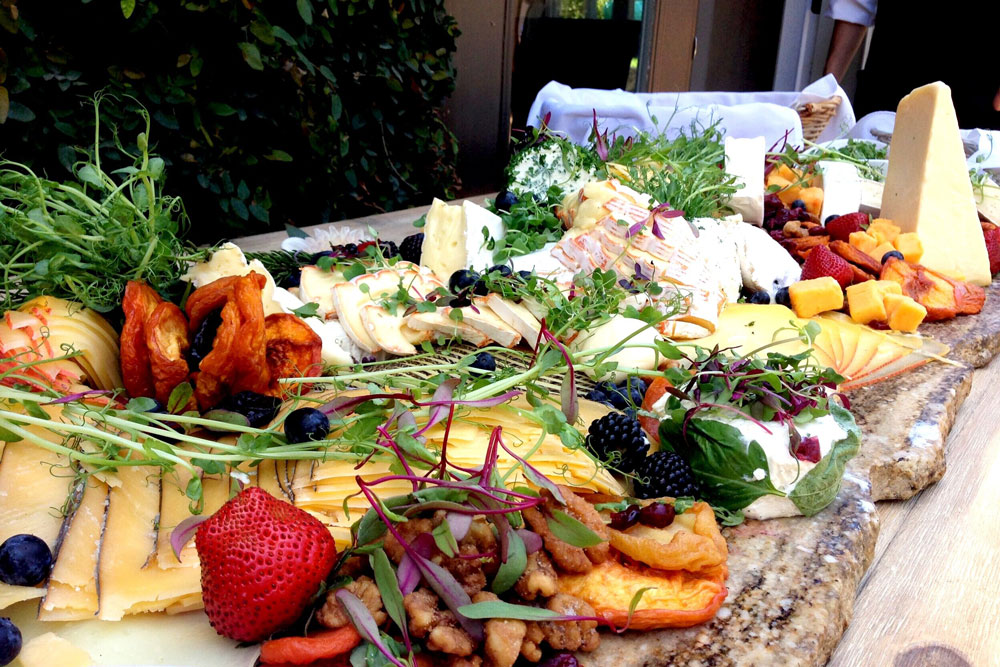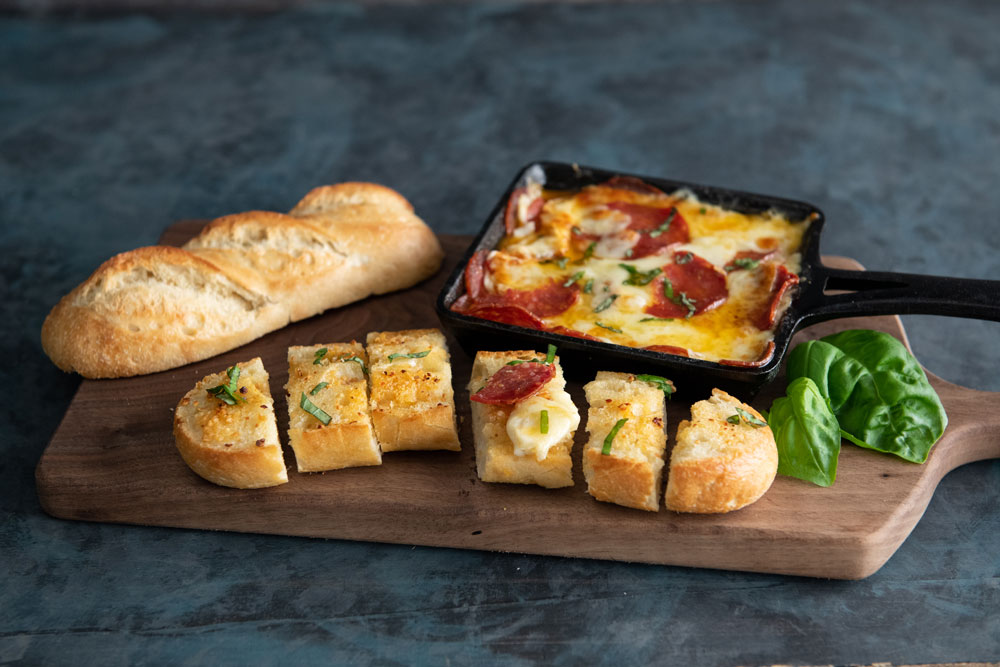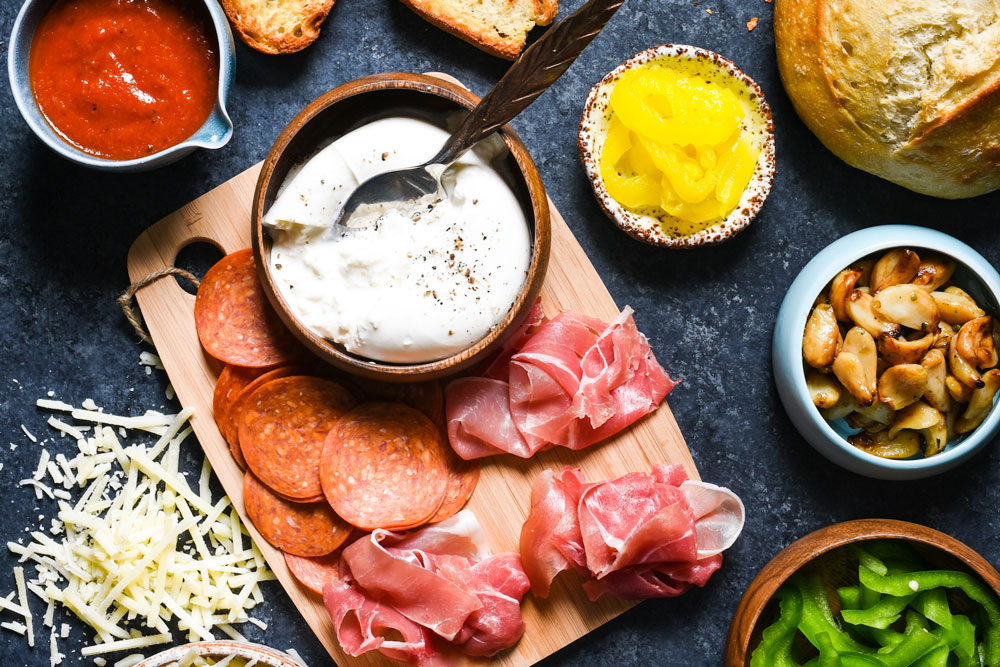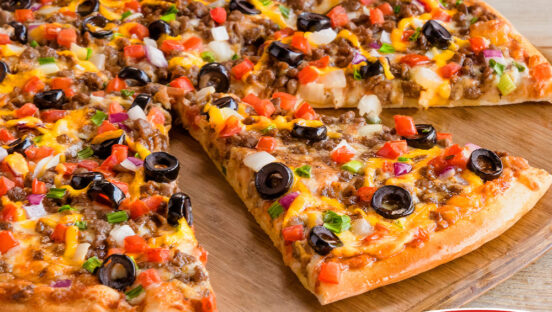By Tracy Morin
Although pizza restaurants are ideal spots for great charcuterie plates, too many of them aren’t yet tapping into this potentially lucrative menu category. “It’s very rare to see pizzerias include charcuterie boards as a menu item—in fact, according to a recent survey by Technomic Ignite, charcuterie is ranked No. 482 of non-pizza items on pizzeria menus,” notes Brie Buenning, director of marketing for La Brea Bakery, based in Los Angeles. “This points to charcuterie being largely underutilized in pizzerias, despite these kinds of restaurants likely having all of the components needed for a great board.”
Take advantage of your in-house items with these plates of mix-and-match magic—and don’t forget to market them smartly to reap maximum profits. Here are some ideas to get you started.

Courtesy Craft Wood Fired Catering
“By selecting [beers and wines] that are complementary—both in flavor and price—to the charcuterie offerings, you can add an extra layer of flavor and spark interest among customers.”
— Kyle Jones, Craft Wood Fired Catering
Selling Charcuterie
The Right Stuff. Buenning explains that pizzerias already have on hand a plethora of ingredients found on charcuterie boards, such as salami, prosciutto, pepperoni, other cured meats, vegetables and cheeses. By simply adding artisan baguettes and other breads (as well as various accompaniments like honey, nuts or dried fruit), you can easily create an attractive menu item.
Or, for extra credit, allow customers to craft their own! “Just as ordering a pizza offers endless combinations, enabling customers to order customized charcuterie boards will make the boards a natural extension of your main menu item,” Buenning says. “A pizzeria could even offer charcuterie that emulates a grazing board—think mini pizzas, garlic bread, calzones, breadsticks, dippable items with pizza sauces, etc.”
After all, Buenning points out, if the recent “butter boards” trend (in which TikTok and Instagram were suddenly awash in fancied-up butters) proved anything, it showed you can make a charcuterie board however you want. Plus, plates that diners can split are already right at home in a pizzeria. “Consumers have always loved pizza because it’s shareable,” Buenning says. “A charcuterie board elevates that experience by adding an interactive element to the meal.”
Try this recipe: Grandé’s Charcuterie Board Pizza
Pricing for Profit. When pricing your plates, take all factors into account to make sure they are worth your time. “For maximum profit, you have to consider the costs associated with procuring quality ingredients, plus the time, labor and resources that go into preparing the charcuterie,” advises Kyle Jones, head chef at Craft Wood Fired Catering in Santa Barbara, California. “You also want to look at the competition in the market and account for how much the customer is willing to pay for these kinds of offerings. By being mindful of these factors, you’ll establish a price that will maximize profit.”
For example, if you’re curing your own meats in-house, you might charge more for that time and labor expenditure—and customers will be willing to pay more, since it feels like a more artisanal item. But, if you’re using ingredients already on hand, you might keep prices lower. Buenning advocates a balance of value and profitability, but utilizing ingredients already found in your pizzeria will prevent you from having to bring in anything additional, which helps cut down on food waste and keeps costs low.
“Including suggestions for beverages or selling charcuterie with a drink flight [will] support consumers in making the choice to purchase.”
— Brie Buenning, La Brea Bakery
Pairing Pointers. When marketing charcuterie, Jones suggests, try to create a unique pairing that will draw customers in. “Charcuterie boards that include a mix of cured meats and other accompaniments are popular and can be tailored to include more interesting ingredients and flavors,” he explains. “Advertising your use of seasonal ingredients and locally sourced products can also be an effective way of enticing customers.”
Additionally, you might choose to boost profits further by pairing wines and beers with your charcuterie. “By selecting products that are complementary—both in flavor and price—to the charcuterie offerings, you can add an extra layer of flavor and spark interest among customers,” Jones says. “Also, educational content that demystifies pairing selections can provide a further opportunity to engage with customers as well as increase profits through drink sales.”
Buenning agrees, noting that anytime you can guide a customer to pair a meal with wine, beer or a mocktail, the upsell will support an increased check average that is crucial in today’s challenging restaurant environment. “Waitstaff adding personal suggestions and education as to which beverages will enhance the flavor profiles of their foods not only helps the customer but also highlights the expertise of your team,” Buenning explains. “Including suggestions for beverages or selling charcuterie with a drink flight are other ways to support consumers in making the choice to purchase.” Through the right pairings, both the appetizer and beverages are sorted—consider it a one-two punch of profit before the main meal has even begun.
Making the Sale. Buenning notes that, in years past, many pizzerias started customers with free baskets of fresh breadsticks, French bread or garlic knots to feed them until the meal was served—but, with rising costs, many pizzerias have eliminated those complementary offerings. “Putting charcuterie on the menu is a great way to ‘keep bread on the table’ for customers, offering them a way to start their meals while at the same time making a profit,” Buenning says. “Whether your pizzeria has counter service or table service, have your staff offer the boards as a starter by asking customers, ‘Do you want to start off with a charcuterie board?’ It’s an easy way to let your customers know about them.”
Other tactics that Buenning advises: Place signage throughout the restaurant—at the counter, tabletops, etc.—and ensure savvy menu placement. “If a pizzeria opts to have more of a grazing board with multiple offerings, those are great to market for pizza-popular events and on any catering menus,” Buenning adds. “Many people may not think of a charcuterie offering at a pizzeria, so it’s important to find fun ways to communicate and market the menu addition appropriately, and to ensure that it is positioned as a natural extension of the menu.”
Tracy Morin is PMQ’s senior copy editor and the editor of PizzaVegan.com.

Molten Pizza Dip
Provided by La Brea Bakery
This savory dip can easily be a great starter for a charcuterie board. Just add breads on the side and customize toppings as desired!
Ingredients
- 1 demi French baguette
- ½ c. pepperoni slices
- 8-10 slices provolone cheese
- Fresh basil
- 1 tsp. garlic, minced
- 1 tbsp. butter, softened
- 1 tsp. hot honey
- 1 tsp. red pepper
Heat the oven to 350˚F. In a small cast iron skillet, layer the cheese and pepperoni slices, alternating until the skillet is full. Bake in the oven until the cheese is completely melted and starting to brown. Cut the demi French baguette in half lengthwise; spread butter evenly on both halves. Add garlic and red pepper to each side and place in the oven to toast. Remove and cut crosswise into 1” pieces. Remove the pepperoni dip from the oven, drizzle with hot honey, garnish with fresh basil, and serve with toasted garlic bread.













